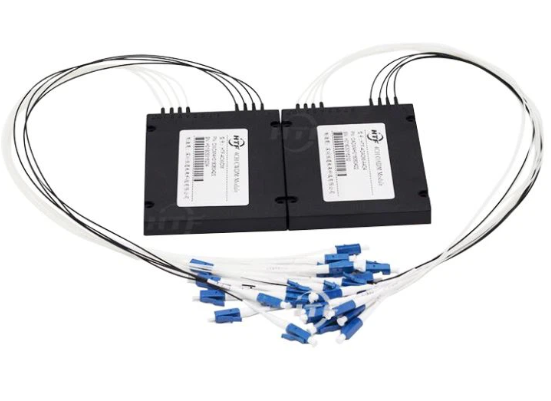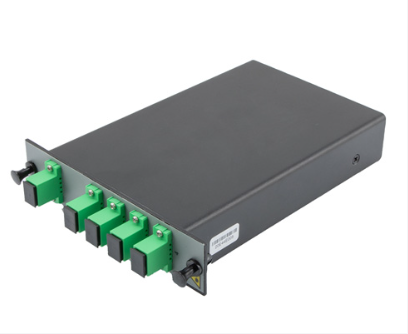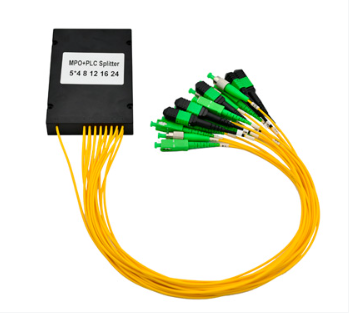The Fundamentals of PLC Splitters in Fiber Optic Networks

Understanding PLC Splitters
In the realm of fiber optic networks, a PLC splitter plays a crucial role in ensuring efficient signal transmission. But what exactly is a PLC splitter and why is it so important in this context?
What is a PLC Splitter?
A PLC splitter is a device designed to divide one or two light beams into multiple light beams uniformly or combine multiple light beams into one or two light beams. Its basic function lies in the even distribution or combination of optical signals with minimal loss and high reliability.
The importance of PLC splitters in fiber optic networks cannot be overstated. These devices are essential for distributing optical signals to multiple locations for processing, making them indispensable components for seamless signal transmission in such networks.
Components of a PLC Splitter
When dissecting the inner workings of a PLC splitter, two key components come to the forefront:
Optical Fibers and Waveguides
These form the backbone of the PLC splitter, serving as the conduits through which optical signals travel, ensuring their smooth and uniform distribution.
Planar Lightwave Circuit Technology
At the heart of every PLC splitter lies this advanced technology, enabling precise splitting and combining of optical signals with minimal loss and maximum efficiency.
The Working Principle of PLC Splitters
In order to comprehend the working principle of PLC splitters, it is essential to delve into how these devices operate and the advantages they offer in fiber optic networks.
How PLC Splitters Operate
Splitting and Combining Light Beams
PLC splitters function by splitting one or two incoming light beams into multiple light beams or combining several light beams into one or two output fibers. This process is achieved through the precise manipulation of optical signals, ensuring efficient distribution without compromising signal integrity.
Uniform Distribution of Optical Signals
One of the key functions of PLC splitters is to ensure the uniform distribution of optical signals across multiple output fibers. This uniformity is vital for maintaining signal strength and integrity throughout the network, enabling seamless communication and data transmission.

Advantages of Using PLC Splitters
Minimal Loss and High Reliability
An inherent advantage of PLC splitters is their ability to split or combine optical signals with minimal loss, ensuring that the transmitted signals retain their strength and quality. Additionally, these devices are known for their high reliability, making them indispensable components in fiber optic networks.
Wide Range of Wavelength Support
Another significant advantage offered by PLC splitters is their capability to support a wide range of wavelengths, typically ranging from 1260nm to 1650nm. This versatility allows them to accommodate various types of optical signals, making them suitable for diverse applications within fiber optic networks.
Types and Benefits of PLC Splitters
In the realm of fiber optic networks, PLC splitters come in various types, each offering unique configurations to cater to specific network requirements.
Different Types of PLC Splitters
1xN and 2xN Configurations
PLC splitters are available in two primary configurations: 1xN and 2xN. The 1xN configuration allows for the splitting of one input fiber into multiple output fibers, catering to scenarios where signal distribution to multiple locations is essential. On the other hand, the 2xN configuration enables the combining of multiple input fibers into one or two output fibers, facilitating the aggregation of signals from diverse sources.
Miniature and Module Types
In addition to different configurations, PLC splitters also come in miniature and module types. Miniature PLC splitters are compact and space-efficient, making them ideal for deployment in environments with limited space availability. Conversely, module PLC splitters offer scalability and flexibility in network design, allowing for seamless integration into larger fiber optic infrastructures.
Key Benefits for Fiber Optic Networks
Enhanced Signal Distribution
One of the primary benefits of utilizing PLC splitters in fiber optic networks is their ability to enhance signal distribution. By efficiently splitting or combining optical signals with minimal loss, these devices ensure that signals are uniformly distributed across multiple output fibers. This enhanced signal distribution contributes to maintaining optimal signal strength and integrity throughout the network.
Scalability and Flexibility in Network Design
Another key advantage offered by PLC splitters is their role in enhancing scalability and flexibility in network design. Whether deploying a miniature splitter for space-constrained environments or integrating module splitters into expansive network architectures, these devices enable network designers to adapt and expand their infrastructure according to evolving requirements without compromising on signal quality or reliability.

Applications and Future of PLC Splitters
As fiber optic technology continues to advance, the applications of PLC splitters in optical networks are expanding, catering to diverse communication and data transmission needs.
Current Applications in Optical Networks
Telecommunications and Broadband Services
PLC splitters play a pivotal role in telecommunications and broadband services, where the efficient distribution of optical signals is essential for seamless connectivity. By enabling the uniform splitting or combining of optical signals, these devices facilitate the reliable transmission of data and voice communications across extensive network infrastructures.
Cable TV and Data Centers
In the realm of cable TV and data centers, PLC splitters are instrumental in ensuring the efficient distribution of optical signals to support high-definition television services and robust data processing capabilities. Their ability to maintain signal integrity while distributing optical signals across multiple output fibers makes them indispensable components for delivering uninterrupted entertainment and data access.
The Future Role of PLC Splitters
Advancements in Fiber Optic Technology
As advancements in fiber optic technology continue to unfold, the future role of PLC splitters is poised for further expansion. With ongoing developments in optical signal processing and transmission, these devices are expected to play an increasingly vital role in supporting next-generation communication networks with enhanced speed, capacity, and reliability.
Meeting the Demand for High-Speed Internet
The proliferation of high-speed internet services has created a growing demand for robust and scalable network infrastructures. In this context, PLC splitters are anticipated to contribute significantly to meeting this demand by enabling efficient signal distribution within fiber optic networks, thereby supporting high-speed internet access for residential, commercial, and industrial applications.
See Also
Discovering the Advantages of the 960 Core Fiber Optic Splice Closure
Attaining Optimal Performance and Affordable Fiber Optic Connection
The Strength of ADSS Fiber Optic Dead End Kits in Cable Networks
The Function of Fiber Optic Cables in Underground Setups
Advantages of ADSS Fiber Optic Cables for Overhead Transmission Lines


